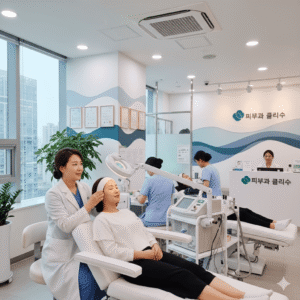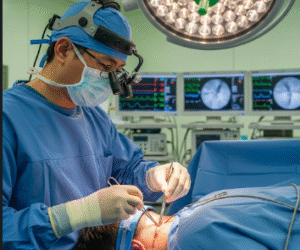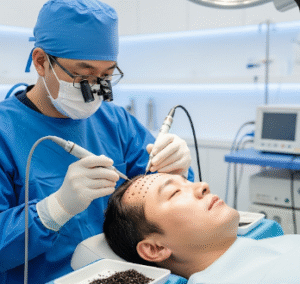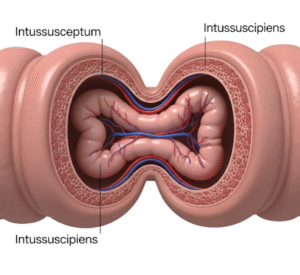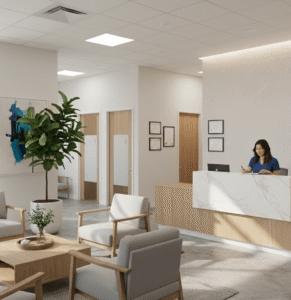What It Is
The Le Fort I osteotomy is a type of upper jaw (maxilla) surgery performed to reposition the maxilla for both functional and cosmetic reasons. The procedure involves cutting the maxilla above the teeth roots and below the eye sockets, allowing surgeons to move the upper jaw forward, backward, upward, or downward.
This surgery is often performed as part of two-jaw (orthognathic) surgery, but it can also be done as a standalone procedure. In Korea, the Le Fort I osteotomy is widely practiced with advanced planning tools like 3D CT imaging and surgical navigation systems, ensuring precise bone movement and natural facial outcomes.
Why It’s Done
Medical Reasons:
- Corrects dental malocclusion (open bite, underbite, or overbite)
- Improves chewing, speech, and breathing functions
- Treats obstructive sleep apnea in select cases
Cosmetic Reasons:
- Improves midface projection in patients with a “flat” or recessed upper jaw
- Balances facial proportions, particularly in profile view
- Enhances harmony between the nose, lips, and chin
Patient Considerations:
- Commonly performed in adults with completed facial growth
- May be combined with lower jaw surgery or rhinoplasty for comprehensive results
- International patients often choose Korea due to the combination of functional correction and aesthetic refinement
Alternatives
- Orthodontic Treatment Alone: Helpful for mild bite issues but insufficient for skeletal discrepancies
- Fillers or Fat Grafting: Improve midface volume but do not reposition bone
- Midface Implants: Cosmetic-only solution; no functional benefit
- Two-Jaw Surgery: Often includes both Le Fort I osteotomy (upper jaw) and BSSO (lower jaw)
Preparation
Before Le Fort I osteotomy in Korea, patients undergo:
- Consultation: With oral and maxillofacial surgeons, orthodontists, and plastic surgeons
- 3D Imaging and CT Scans: For precise bone mapping and surgical simulations
- Orthodontics: Pre-surgical braces or aligners to align teeth properly
- Health Evaluation: Blood tests, physical exams, and medical history review
- Pre-Operative Instructions: Stop smoking, alcohol, and blood-thinning medications several weeks before surgery
- Fasting: Required for 6–8 hours before general anesthesia
How It’s Done
Type: Major surgical procedure under general anesthesia
Duration: 2–4 hours
Procedure Steps:
- Incisions are made inside the mouth to avoid visible scars
- The surgeon carefully separates the maxilla from surrounding bone structures
- The upper jaw is repositioned as planned (forward, backward, upward, or downward)
- Titanium plates and screws are used to secure the bone in its new position
- Incisions are closed with dissolvable stitches
Hospitalization: Typically requires a 2–4 day hospital stay for monitoring and recovery
Recovery
- First Week: Swelling and bruising are most noticeable; pain managed with medication
- Diet: Liquid or soft food diet for several weeks while bone heals
- Oral Care: Antiseptic rinses and gentle hygiene due to intraoral incisions
- Speech & Function: May feel limited initially but improves with time
- Downtime: Light activities may resume in 3–4 weeks
- Final Results: Stable after 3–6 months; full healing may take 9–12 months
Possible Complications
- Swelling, bruising, and temporary numbness in the upper lip or cheeks
- Infection at the surgical site (rare with proper care)
- Sinus complications due to proximity to nasal passages
- Relapse or shifting of the maxilla (minimized with modern fixation techniques)
- Nerve injury, though permanent damage is rare
Treatment Options in Korea
Diagnosis
Korean clinics provide precise evaluations using:
- 3D CT Scans and Imaging for detailed surgical planning
- Computer Simulation Software to preview changes before surgery
- Team Consultations between orthodontists, oral surgeons, and plastic surgeons
Medical Treatments
- Orthodontic correction alone for mild jaw discrepancies
- Fillers or implants for purely cosmetic midface enhancement
Surgical or Advanced Therapies
- Le Fort I Osteotomy Alone: For isolated upper jaw repositioning
- Two-Jaw Surgery (Orthognathic Surgery): Combining Le Fort I with lower jaw procedures like BSSO
- Hybrid Procedures: Sometimes performed alongside rhinoplasty or cheekbone surgery for enhanced results
Rehabilitation and Support
- Frequent follow-up visits to monitor bone healing and stability
- Swelling care treatments, including lymphatic massage or advanced therapies available in Korean clinics
- International patient support: language assistance, recovery accommodations, and long-term monitoring


